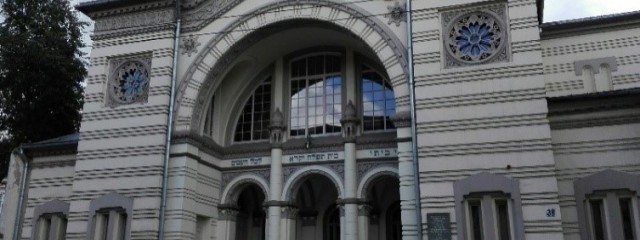Before the II World War, there was a numerous and culturally very active Jewish Community in Vilnius, which was almost completely annihilated during the Nazi occupation and the Holocaust. There are still some traces of them to find in the city and this week I spent one day to find them. This was my little homage to those who died victims of racism, intolerance, and anti-Semitism.
The first stop I made was at the Vilnius Jewish Public Library at Gedimino Pr 24-9. The American book collector Wyman Brent founded this library, and its purpose is to promote Jewish literature as well as to contribute to the preservation of the memory of Jewish culture in Lithuania.
My second stop was to visit the Vilna Gaon Jewish State Museum at Pamėnkalnio g. 12. The museum is also known as “the greenhouse”. The name comes from the famous Torah Scholar, the Gaon of Vilnius, and was given to the museum in 1997 when commemorating the 200th anniversary of his death. I walked around its corridors and halls in which big posters that imitated the Torah scrolls explain the history of Jews in Lithuania. Very well documented and with plenty of illustrations, it is organized in different sections each one related to a particular moment of the Jewish culture, life and history in the country. Especially important is the section dedicated to the II World War period, when the Community was almost annihilated. The first hall is dedicated to the Cultural Jewish heritage, and especially to the Yiddish culture. Yiddish was the common language of communication between Lithuanian Jews, and a wide culture and literature were developed in this language. The rest of the halls are mostly dedicated to the history of Jews, their contribution to the independence of Lithuania, the Nazi occupation, and the Vilnius ghettos. One of the walls is dedicated to those people who risked themselves to save a Jewish life at these difficult dangerous times.
Near the museum, there are two monuments. One of them is devoted to Jan Zvartendijk, the Dutch Ambassador in Lithuania who in 1940 granted around 2.200 visas to Jews. The other one, situated in front of the Museum, is a memorial to Sempo Sugihara, the Japanese Consul in Lithuania who saved 6.000 Jews in 1940. I recommend very much to visit this museum to all those who are interested in Jewish life in Lithuania and especially to those interested in the Jewish Lithuanian Holocaust. The museum has published a lot of books about this subject, they are available in the museum, as well as a complete illustrated catalog of the exhibition.
I would like to copy some words you can find in the catalog, which explains about one of the most important purposes of the museum:
“One of the exhibition’s goals and purposes is to reach the younger Lithuanian generations, to open the door for discussion, friendship and cooperation. What is the Holocaust? Is it possible to feel the pain suffered so many years ago? What did it mean to be a Jew from 1941 to 1944? These are painful questions that pose a challenge and which we hope, are addressed in the exhibition”.
The Vilna Gaon Jewish State Museum
After visiting the Vilna Gaon Jewish State Museum I went to the Tolerance Centre at Naugarduko g. 10 / 2. The Centre belongs to the Vilna Gaon Museum and it is also dedicated to the life and history of Lithuanian Jews. It is to notice that there is a small section of the current Jewish Community, which at the present has about 3.000 souls.
My next goal was to visit the present Jewish Community of Vilnius at Pylimo g. 4. In my way through what the big and the small ghettos were, I could see some traces and monuments to the Lithuanian Jews, like the beautiful one dedicated to Tsemakh Shabad at Rūdninkų g. Tsemakh Shabad was a doctor who was known for his humanity, for caring of children and fo.r being the co-founder or the YIVO (Institute for Jewish Research). I also saw the impressive sculpture devoted to the Vilna Gaon at Žydų g. 5
Monument dedicated to the Vilna Gaon
On my way, I also found the house where the Yiddish writer Moyshe Kulbak lived. Kulbak was one of the greatest poets and novelists in Yiddish language and he was executed in 1937 during the Stalin purges. Near to his house, I encountered the Shofar Café, a Jewish café in the Jewish Information Centre building.
Of course, I also visited the Old Vilnius Choral Synagogue at Pylimo g. 39, which is the only synagogue that is still in use in Vilnius, a city that once had more than 100 synagogues. This synagogue survived both, the Holocaust and the Soviet period.
To finish my visit around the Jewish Vilnius I sat in the Bagel Shop, a nice café that belongs to the Jewish Community. I ate a typical honey cake and I was informed that on Wednesday 20. September will begin the new Jewish Year 5778. So I would like to wish a happy New Year to everybody!
The Lithuanian Jewish Community Building
I would like to finish my article by noticing that the Yiddish language is still alive in Vilnius. Maybe Jews don’t speak it anymore, but you can find many traces of it along the streets of the city.
And for those who are interested in Jewish culture, notice that there is much more to see besides of what I said. Traces and monuments, but also a Yiddish Institute which belongs to the University of Vilnius, and a Judaica Department in the National Library. These and other cultural Lithuanian institutions are contributing to preserving the Jewish heritage in the beautiful city of Vilnius.





Very interesting, so many things….
I see you can spend a whole with visiting all these places….
I am really surprised about your article and what you everything can find in Vilnius. Great time for you!